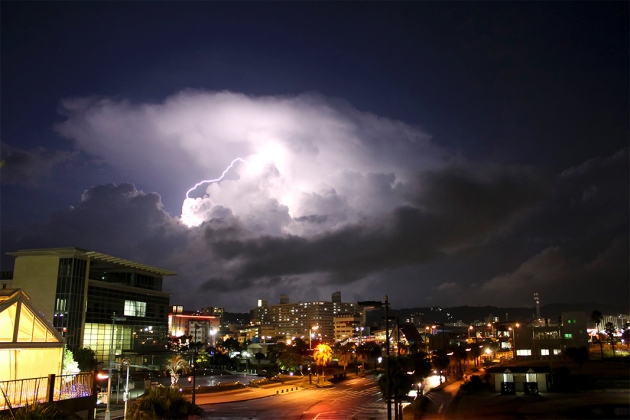The Beauty of Ice
On November 14, Operation IceBridge scientist John Sonntag took this photograph of ice in the Weddell Sea, a part of the Southern Ocean off the Antarctic Peninsula. The geometric shapes are due to a phenomenon known as “finger rafting,” which occurs when two floes of thin ice collide. As a result of the collision, blocks of ice slide above and below each other in a pattern that resembles a zipper or interlocking fingers. Brine expelled from the ice forms a solution that acts as a lubricant. For finger rafting to occur, it’s critical that the ice be thin—calculations suggest no more than 8 inches, or 20 centimeters. Any thicker and the ice loses its flexibility. Without flexibility, thicker ice floes that collide can result in a big pile up known as “ridging.”
A streak of lightning in the skies over Japan has generated positrons — the antimatter equivalents of electrons — and radioactive carbon-14, confirming a theoretical prediction, according to a paper published in Nature on 22 November.
NASA — After more than 13 years at Saturn, and with its fate sealed, NASA’s Cassini spacecraft bid farewell to the Saturnian system by firing the shutters of its wide-angle camera and capturing this last, full mosaic of Saturn and its rings two days before the spacecraft’s dramatic plunge into the planet’s atmosphere.
How the Earth stops high-energy neutrinos in their tracks
For the first time, a science experiment has measured Earth's ability to absorb neutrinos -- the smaller-than-an-atom particles that zoom throughout space and through us by the trillions every second at nearly the speed of light.
On November 14, Operation IceBridge scientist John Sonntag took this photograph of ice in the Weddell Sea, a part of the Southern Ocean off the Antarctic Peninsula. The geometric shapes are due to a phenomenon known as “finger rafting,” which occurs when two floes of thin ice collide. As a result of the collision, blocks of ice slide above and below each other in a pattern that resembles a zipper or interlocking fingers. Brine expelled from the ice forms a solution that acts as a lubricant. For finger rafting to occur, it’s critical that the ice be thin—calculations suggest no more than 8 inches, or 20 centimeters. Any thicker and the ice loses its flexibility. Without flexibility, thicker ice floes that collide can result in a big pile up known as “ridging.”



No comments:
Post a Comment